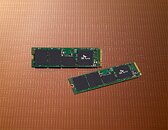- Joined
- Oct 9, 2007
- Messages
- 47,670 (7.43/day)
- Location
- Dublin, Ireland
| System Name | RBMK-1000 |
|---|---|
| Processor | AMD Ryzen 7 5700G |
| Motherboard | Gigabyte B550 AORUS Elite V2 |
| Cooling | DeepCool Gammax L240 V2 |
| Memory | 2x 16GB DDR4-3200 |
| Video Card(s) | Galax RTX 4070 Ti EX |
| Storage | Samsung 990 1TB |
| Display(s) | BenQ 1440p 60 Hz 27-inch |
| Case | Corsair Carbide 100R |
| Audio Device(s) | ASUS SupremeFX S1220A |
| Power Supply | Cooler Master MWE Gold 650W |
| Mouse | ASUS ROG Strix Impact |
| Keyboard | Gamdias Hermes E2 |
| Software | Windows 11 Pro |
SK hynix Inc. announced today that it has started mass production of its 238-layer 4D NAND Flash memory, following the development in August 2022, and that product compatibility test with a global smartphone manufacturer is underway. "SK hynix has developed solution products for smartphones and client SSDs which are used as PC storage devices, adopting the 238-layer NAND technology, and has moved into mass production in May," the company said. "Given that the company secured world-class competitiveness in price, performance and quality for both 238-layer NAND and the previous generation 176-layer NAND, we expect these products to drive earnings improvement in the second half of the year."
The 238-layer product - the smallest NAND in size - has a 34% higher manufacturing efficiency compared to the previous generation of 176-layer, resulting in a significant improvement in cost competitiveness. Besides, with a data-transfer speed of 2.4 Gb per second, a 50% increase from the previous generation, and approximately 20% increase in read and write speed, the company is confident that it will be able to deliver an improved performance to the smartphone and PC customers using this technology.

Once the product compatibility test with the global smartphone manufacturer is completed, SK hynix will begin supplying the 238-layer NAND product for smartphones, and expand the technology across its product portfolio such as PCIe 5.0 SSDs and high-capacity server SSDs going forward.
"We will continue to overcome NAND technology limitations and increase our competitiveness so that we can achieve a bigger turnaround than anyone else during the upcoming market rebound," said Jumsoo Kim, Head of S238 NAND at SK hynix.
View at TechPowerUp Main Site
The 238-layer product - the smallest NAND in size - has a 34% higher manufacturing efficiency compared to the previous generation of 176-layer, resulting in a significant improvement in cost competitiveness. Besides, with a data-transfer speed of 2.4 Gb per second, a 50% increase from the previous generation, and approximately 20% increase in read and write speed, the company is confident that it will be able to deliver an improved performance to the smartphone and PC customers using this technology.

Once the product compatibility test with the global smartphone manufacturer is completed, SK hynix will begin supplying the 238-layer NAND product for smartphones, and expand the technology across its product portfolio such as PCIe 5.0 SSDs and high-capacity server SSDs going forward.
"We will continue to overcome NAND technology limitations and increase our competitiveness so that we can achieve a bigger turnaround than anyone else during the upcoming market rebound," said Jumsoo Kim, Head of S238 NAND at SK hynix.
View at TechPowerUp Main Site





